A Brief History Lines
West
Of
The New York, New Haven and Hartford Railroad Co.
By Philip C. Blakeslee
F O R E W O R D
The following history was written by Mr. Blakeslee at the request
of his friends. It has been checked for accuracy by railroad officials
and railroad historians.
Mr. Blakeslee hired out on the New Haven as fireman in Nov.
1899. He fired on the Air Line, Canal, Shore Line and New York
divisions. Was promoted to engineer on Nov. 29, 1904 and worked
on the Berkshire-Naugatuck division, running out of every engine
terminal on that division, later known as the Western Division.
From January, 1915 until February, 1920, he was Division Examiner
on the Book of Rules, returning to engineer and worked until retired
December 13, 1947.
The maps used in this edition were prepared by your editor,
and are shown for information, they are not true to scale.
The photographs used are from the collection of Mr. Blakeslee
and Mr. D. W. Peckham. As we write these lines, we do not know
how they will turn out, as this will be our first attempt at photo
reproduction.
The Directors of The Railroad Enthusiasts, Inc. hope you will
like this booklet and your comments and criticisms are invited.
Lewis Walter,
Editor,
April 1953
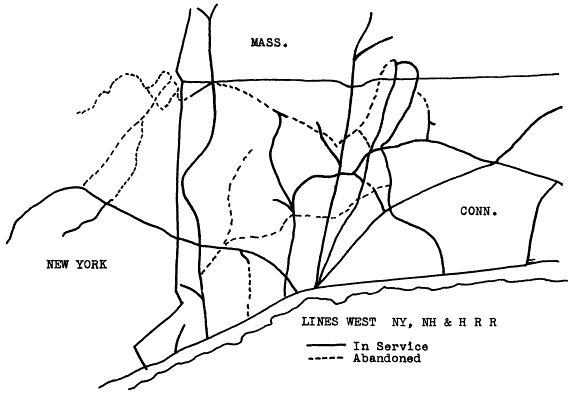
There are some people who say "To Hell with yesterday,
what's doing today?" of course we must take care of the present
and prepare for the future, but for those who are interested in
our railroad, it is hoped that this little history may be of some
interest.
For a number of years in the fore part of the century, the
territory west of New London and Willimantic, Conn. was known
as "Lines West", and east of these points as "Lines
East". A number of original independent railroads once comprised
the Lines West territory which later became a part of the present
New York, New Haven and Hartford System and we are trying to give
dates and other matters pertaining to them.
Much of the historical information about the old Housatonic
and also the Air Line, Shore Line and other parts of the railroad
was furnished by Mr. D. W. Peckham, retired train dispatcher.
Mr. Peckham was a train dispatcher of very unusual ability. He
dispatched trains on the Berkshire, Air Line, Shore Line and Naugatuck
Lines. In his time the single track roads were alive with trains.
In the early 1900's, on the Berkshire, there were five or six
second class trains each way every night. They all had time card
meeting points between New Milford and Canaan, 38 miles, and not
a night operator on duty between these points and dispatchers'
telephones hadn't been thought of at that time. Peckham would
turn those trains loose at Canaan and New Milford with meet orders
on the five or six trains and if none of the brothers stubbed
their toes, the meets would all be made with little or no delay.
Conductors and engineers were always glad when they received orders
signed (CX). Mr. Peckham has a wonderful memory and his source
of information on old time railroading is unlimited.
P. C. Blakeslee
January 27, 1952
THE HARTFORD AND NEW HAVEN RR— THE NEW HAVEN
AND NORTHAMPTON RR
The Hartford and New Haven Railroad, New Haven's first railroad
was opened in New Haven to North Haven in November, 1838. An old
newspaper gives an account of this first trip, and states that
the return trip from North Haven to New Haven was made, in 19
minutes, which was considered good time and as a matter of fact,
is 10 or 12 minutes faster between those points than the time
made today by the so-called "modern" bus transportation!
The road, originally planned to go via Middletown, was opened
to Meriden December 3, 1838 and to Hartford in 1839 and reached
Springfield in 1844.
The Berlin-Middletown branch was opened in 1850. The Berlin-New,
Britain branch was opened January 1863 and the Suffield branch,
Windsor Looks to Suffield opened in 1870.
The New Haven and Northampton Railroad was opened New Haven
to Plainville in January 1848 and to Westfield, Mass. in 1855,
and to Northampton in 1858. In 1881 it was opened to a point east
of Shelburne Falls at Conway, on what is now the Boston and Maine
Railroad formerly Troy & Greenfield and Fitchburg RR.
What is now known as the New Hartford branch was opened November
1, 1876.
The Holyoke and Westfield Railroad, now Holyoke branch, was
opened for freight October 16, 1871 and for passenger service
Nov. 25, 1871.
The Williamsburg branch, Williamsburg to Northampton, was opened
February 1, 1868. The South DeerfieldTurners Falls branch was
opened October 31, 1881.
The New Haven and Northampton RR had more branches than any
of the other lines. In the early 1900's this road, called unofficially
"The Canal" was a very busy railroad. There were four
passenger trains a day each way in and out of New Haven; there
were also 8 time table, 2nd class, freight trains, every day and
from 1 to 5 call extras out of New Haven.
Also for 2 or 3 years prior to 1905, there were 5 passenger
trains a day each way between New Haven and Waterbury via the
Cheshire Loop and the Meriden Branch, formerly the Meriden, Waterbury
and Connecticut River RR. These trains made the trip from New
Haven to Waterbury, Dublin Street Station, in 50 minutes. These
trains were well patronized. They often sent an engine from Hartford
on Sunday nights to help the trains over the steep grade from
West Cheshire to Summit. The coming of the New Haven-Waterbury
trolleys spelled their doom and these trains were discontinued
in the fall of 1905. Dispatcher telephones were first tested out
on this line in 1909.
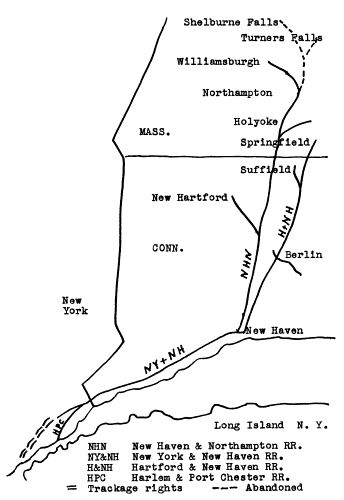 In the early
days, the Canal Railroad ran in the street from Todd Street, Mount
Carmel, to a point near the Masonic Home in Centerville, but the
horses did not seem to care for the choo-choos so the track was
moved to its present location.
In the early
days, the Canal Railroad ran in the street from Todd Street, Mount
Carmel, to a point near the Masonic Home in Centerville, but the
horses did not seem to care for the choo-choos so the track was
moved to its present location.
May 14, 1887, the New Haven and Northampton Railroad was leased
to the New York, New Haven and Hartford Railroad and was then
known as the Northampton Division of that road. For a number of
years, Mr. R. G. Curtis was Superintendent of the Northampton
Division. In the early 1900's the Northampton Division was combined
with the Air Line Division and was then known as the Air-Line-Northampton
Division.
THE NEW YORK AND NEW HAVEN RAILROAD
THE HARLEM AND PORT CHESTER RAILROAD
The New York and New Haven Railroad was a very expensive road
to build, because of the many wide rivers it had to span; however,
on December 29, 1848, it was opened from New Haven to the Williams
Bridge, N. Y. where it connected with the Harlem Railroad and
used their tracks into New York City, which is still being done
today. It is hard to realize that this railroad was once a single
track road, but it didn't last long as it was soon evident that
a single track would not handle the business and in 1850 the double
tracking was started and completed in 1853. In the 90's, the four
tracking was started and completed in the early 1900's.
The Harlem and Port Chester Railroad, now known as the Harlem
River branch, was opened Harlem River to New Rochelle November
24, 1873.
In the early 1900's the big freight yard at Oak Point was built,
the gravel for the fill was hauled from Naugatuck Junction, now
Devon, in Pratt sideboard cars, 24 cars were a train for a K-1
engine.
Later there were six main tracks from Oak Point to New Rochelle
Junction. It was a beautiful sight leaving New Rochelle Jct. to
look at those 12 shining rails all kept bright with heavy traffic.
It made you think of the boomer brakeman who had been out of service
for some time, (cause unknown); at last he was back on the railroad
again and on his first trip he said, "Shining Rails, I'm
Yours Again."
It is doubtful that when the Harlem and Port Chester Railroad
was built, anyone had any idea that some day it would be such
an important link in the all-rail line between New England and
all points in the South and West. This was made possible by that
wonderful engineering feat, the building of the Hell Gate Bridge,
which marks one of the boldest, most gigantic projects in the
history of American railroad development. The engineering world
had been watching and marveling at this wonderful construction
for the four years that the massive work was in progress. This
bridge was opened on April 1, 1917 and today there are trains
running over this bridge from Montreal, Boston and other points
to Washington, Pittsburgh and the South.
Well, to get back to the New York and New Haven Railroad. In
the early days, the railroads were built inland, as the people
living along the shore thought that the boats were all they needed
for transportation, but it seems that the boats were losing some
of their customers to the New York and New Haven Railroad as an
advertisement appears in the Columbian Register of New Haven,
dated October 6, 1849 reading as follows:
TO THE TRAVELING PUBLIC
The Way to Save Your Money
Pay your fares no further than Bridgeport by Railroad. Take
the steamboat Cricket, William H. Peck, Commander, at Bridgeport
which leaves for New York every afternoon at 2 o'clock, Sundays
excepted. Passage 50 cents.
NB. By taking this route you save fifty cents and breathe fresh
air which is much pleasanter than the dusty cars. This boat arrives
in New York about 5½ o'clock.
Well there are no more dusty cars now between Bridgeport and
New York, as the road was electrified to Stamford around 1906
and extended to New Haven in 1913. Also the roadbed is stone ballasted,
as are most all of the main lines.
The Shore Line Railroad was leased to the New York and New
Haven Railroad in 1870 and on August 6, 1872, the New York and
New Haven and the Hartford and New Haven railroads were consolidated,
forming the New York, New Haven and Hartford Railroad.
The Stamford and New Canaan Railroad, (New Canaan branch) was
opened July 4, 1868.
THE HOUSATONIC RAILROAD
The Housatonic Railroad was opened in 1840 between Bridgeport
and New Milford.
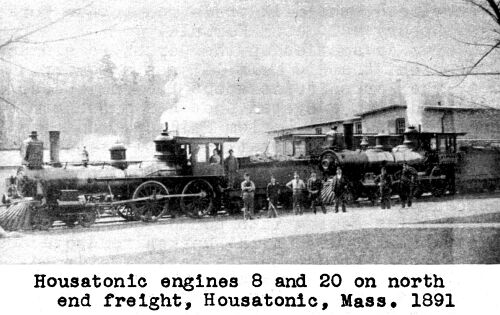 An old copy
of the Bridgeport Standard gives information on the first train
that ran from Bridgeport to New Milford February 11, 1840. It
states that the black ponies going tandem (meaning doubleheader
to us) left Bridgeport at 9 o'olock in the morning taking with
them some forty rods of cars. The train was decotated with flags,
etc., and accompanied by the Bridgeport Band, it made a very imposing
appearance. The first timetable stated that on and after Wednesday,
February 19, 1840, the cars would leave New Milford every morning,
Sunday excepted, at 6 o'clock a.m. and arrive in Bridgeport in
time for passengers to take the steamboat for New York and leave
Bridgeport on arrival of the steamboat from New York about 2 p.m
An old copy
of the Bridgeport Standard gives information on the first train
that ran from Bridgeport to New Milford February 11, 1840. It
states that the black ponies going tandem (meaning doubleheader
to us) left Bridgeport at 9 o'olock in the morning taking with
them some forty rods of cars. The train was decotated with flags,
etc., and accompanied by the Bridgeport Band, it made a very imposing
appearance. The first timetable stated that on and after Wednesday,
February 19, 1840, the cars would leave New Milford every morning,
Sunday excepted, at 6 o'clock a.m. and arrive in Bridgeport in
time for passengers to take the steamboat for New York and leave
Bridgeport on arrival of the steamboat from New York about 2 p.m
December 1, 1842, the Housatonic Railroad was completed to
the Massachusetts-Connecticut state line. The Berkshire Railroad
was opened up at this time between that point and West Stockbridge.
The West Stockbridge Railroad was built from West Stockbridge
to State Line Mass. and was opened April 10, 1844. Both of these
roads became part of the Housatonic Railroad. 'The Stockbridge
and Pittsfield Railroad was opened between Van Deusenville and
Pittsfield on Dec. 24, 1849. The Housatonic operated this road
under perpetual lease.
The New York Housatonic and Northern Railroad, Danbury to Brookfield
Jct., conveyed to William H. Barnum, as Trustee for the Housatonic,
May 6, 1881. This portion of the road is part of the route over
which New York-Pittsfield express trains have been running for
well over half a century.
The Danbury and Norwalk Railroad between Danbury and South
Norwalk opened February 22, 1852 and was leased to the Housatonic
Railroad July 21, 1887. This has been a busy piece of railroad.
July 1882, this road was extended South Norwalk to Wilson Point.
The Ridgefield branch, Branchville to Ridgefield opened July
1, 1870.
The Hawleyville Branch, Bethel to Hawleyville, was opened July
1872 and was abandoned June 6, 1911 and with the exception of
the portion of the Meriden, Waterbury & Connecticut River
Railroad, between Westfield, Conn., and Cromwell, this was the
first portion of railroad abandoned on Lines West.
The New Haven and Derby Railroad was opened New Haven to Ansonia
(or, Derby Jct.,) August 5, 1871. The Railroad YMCA on South Orange
Street, New Haven, was formerly the New Haven and Derby Depot.
This building was later moved 50 feet to its present location.
The New Haven and Derby engine house was located at West Street,
New Haven.
November 14, 1888, the New Haven and Derby opened an extension,
Derby Jct. to a point in Huntington, 3.79 miles.
November 28, 1888 the Housatonic Railroad opened a branch from
Botsford to connect with New Haven and Derby extension, 9.79 miles.
Old timers used to refer to this portion of the road as the extension
and at that time freight trains were run from New Haven to Wilson
Point via Botsford, Hawleyville and Bethel.
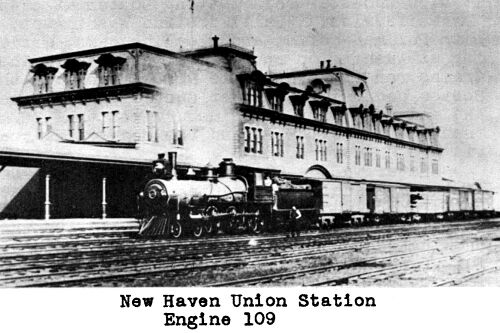 The New Haven
and Derby Railroad was leased to the Housatonic Railroad July
9, 1889 and the Housatonic Railroad was leased to the New York,
New Haven and Hartford September 10, including the Danbury and
Norwalk and the New Haven and Derby Railroads. Passenger trains
of the former Housatonic Railroad, known for many years as the
Berkshire Division, were run to the Union Station, New Haven.
The New Haven
and Derby Railroad was leased to the Housatonic Railroad July
9, 1889 and the Housatonic Railroad was leased to the New York,
New Haven and Hartford September 10, including the Danbury and
Norwalk and the New Haven and Derby Railroads. Passenger trains
of the former Housatonic Railroad, known for many years as the
Berkshire Division, were run to the Union Station, New Haven.
Housatonic is an Indian name and many people and old records
call it Ousatonic, claiming that when the English came they put
an "H" at the beginning of the word. No doubt they are
right as there are few Indian names that begin with an H.
Around 1913, the Berkshire was double-tracked from Berkshire
Jct. to New Milford.
Mr. Mellen, who was President of the road, had plans to make
many improvements north of New Milford; he also had a line surveyed
from State Line, Mass., to a point on the Rutland, planning to
install through service over this route to Montreal, but for some
reason the plan was dropped, and a few years later the line from
Berkshire Jct. to New Milford was restored to single track operation.
In an interesting newspaper account of Mr. Fred Tanners' (conductor)
railroad career of 56 years, it states that a passenger train
left State Line at 9:00 a.m. arriving at Bridgeport at 3:00 p.m.
in the 1860's. A stop was made at Merwensville for dinner, the
conductor was required to sit at the head of the table whether
or not he ate. When he arose, it was a signal for passengers to
get back on the train. The old hotel still stands beside the tracks
of the railroad.
There was still standing, in West Stockbridge, as late as 1916,
a building which served as the first roundhouse in Massachusetts.
It was built when West Stockbridge was the eastern terminal of
the Hudson and West Stockbridge Railroad.
The Berkshire is noted for its beautiful scenery, running in
sight of the clean Housatonic River much of the way. Then there
are many interesting things to see, among them Lover's Leap near
where Still River empties into the Housatonic River about three
miles south of New Milford. Still River is one of the few rivers
that runs north. After passing through the fine towns of New Milford
and Kent, you can see Kent Falls on the right. These falls are
unusual in that they don't fall directly, but plunge down a perfect
rock stairway. Then come the Cornwalls. Cornwall Bridge Station
is one of the most picturesque country stations that can be found
anywhere. It is located close to the river and at this point the
valley is narrow and with the wide river and the mountains on
both sides, making a beautiful picture. On Canaan station, there
is a locomotive weather vane which has been there since the 70's.
One day in the 1920's, two men were sent up from Danbury to take
it down. Just as they had it down on the platform, Mr. Ed Finonery,
the agent, happened to come along and saw it. He took off his
hat, spit, put his hat on, spit again, and wanted to know who
told the men to take it down. They told him they had orders to
bring it to Danbury where it was to be cleaned up and placed in
the Superintendent's office. Ed told them that the weather vane
didn't belong to the railroad, it belonged to the town of Canaan
and it would have to be put back. The men, however, took it to
Danbury as ordered, but in three days they brought it back and
put it in its former place and it is still there.
 After leaving
Canaan, we pass through the fine towns of Sheffield and Great
Barrington; many of the railroad men on the Housatonic Railroad
came from these towns, but West Stockbridge holds the record as
the birthplace of railroad men. New Milford also furnished quite
a few, and several of the men born in those towns, after giving
many years of good service, were made members of the Royal Family.
After leaving
Canaan, we pass through the fine towns of Sheffield and Great
Barrington; many of the railroad men on the Housatonic Railroad
came from these towns, but West Stockbridge holds the record as
the birthplace of railroad men. New Milford also furnished quite
a few, and several of the men born in those towns, after giving
many years of good service, were made members of the Royal Family.
After passing Housatonic, we soon come to the famous curve
south of Glendale, then into Stockbridge; from here a fine view
of the old man of the mountain may be had. Then past the marble
quarries at Lee and on to Lenox, which was known as the summer
home of millionaires. The New York-Pittsfield express, which ran
Saturday afternoon only, was called the "Millionaire's Express."
The morning express out of New York and the afternoon express
out of Pittsfield in the early 1900's were known as the Lenox
Express.
Soon after leaving Lenox, we arrive in the busy and attractive
city of Pittsfield, the end of the line, being thoroughly rested
after our ride through this beautiful country in streamlined,
air-conditioned cars.
Besides the New York-Pittsfield express, another famous train
was the Milk Train, locally known as the "Big Milk".
This train ran from Pittsfield to Bridgeport, picking up and loading
milk as far as Newtown, arriving in Bridgeport with from 25 to
30 carloads every day. From there, the train ran to New York.
After the creameries at Hawleyville and Newtown closed, the milk
train ran to New York via Danbury and South Norwalk.
The creameries up the Berkshire are now closed and the Big
Milk is just a memory.
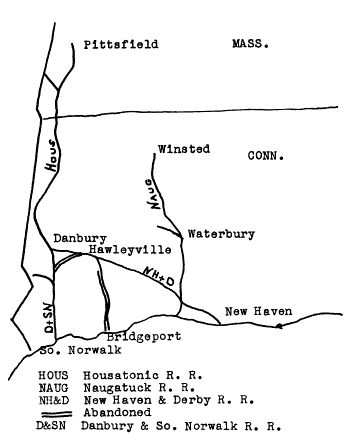 The Berkshire is about the only piece of railroad on the system
that has passenger train competition. The Harlem Railroad, Chatham
to New York, has many stations on its line only a few miles west
of the stations on the Berkshire. At one time the Berkshire had
a large percentage of the New York travel, but with automobiles
coming into common use, many people from towns on the Berkshire
drove over to nearby stations on the Harlem Railroad. This went
on for some time and a good part of the New York travel went over
to the Harlem. In 1935-6, the New Haven decided to promote business
to and from Berkshire County and a concerted effort was made to
recapture the traffic which had left the Berkshire and had gone
to the Harlem Division of the New York Central from Hillsdale,
N. Y. With the cooperation of the business interests, hotels and
recreational centers, the Passenger Department's promotional program
resulted in increasing the New York-Berkshire County traffic and
recapturing the traffic which was moving on the Harlem Division.
The Berkshire is about the only piece of railroad on the system
that has passenger train competition. The Harlem Railroad, Chatham
to New York, has many stations on its line only a few miles west
of the stations on the Berkshire. At one time the Berkshire had
a large percentage of the New York travel, but with automobiles
coming into common use, many people from towns on the Berkshire
drove over to nearby stations on the Harlem Railroad. This went
on for some time and a good part of the New York travel went over
to the Harlem. In 1935-6, the New Haven decided to promote business
to and from Berkshire County and a concerted effort was made to
recapture the traffic which had left the Berkshire and had gone
to the Harlem Division of the New York Central from Hillsdale,
N. Y. With the cooperation of the business interests, hotels and
recreational centers, the Passenger Department's promotional program
resulted in increasing the New York-Berkshire County traffic and
recapturing the traffic which was moving on the Harlem Division.
We can't leave the Berkshires without saying a few words in
memory of the famous pies and other good things we had to eat
in the lunch room in Canaan station. They were remembered by people
from all parts of, the country. It is said that once an, European
Ambassador stopped there and ate some of the famous pies and when
he returned to Europe, he wrote a poem about them. It gives us
a feeling of sadness to learn that the famous lunch room is no
more.
The large frog
that has been sitting in a pond near Lenox since long before the
railroad was built, is still on the job, as the story is told
about an engineer who was running engine number 10. Quite often
his train was late and it is said that when his train went by,
the frog would croak "No. 10 late again."
For many years, the Housatonic R. R. shops were located in
Falls Village, but soon after the Housatonic was leased to the
New York, New Haven and Hartford, these shops were closed and
the repair work transferred to New Haven Shops.
The Berkshire is now part of the New Haven Division, and with
its connections with the Boston & Albany at Pittsfield and
State Line, makes an important outlet to points west.
THE NAUGATUCK RAILROAD
The Naugatuck Railroad was opened to Waterbury on June 11,
1849 and to Winsted on September 24, 1849.
The Waterbury and Watertown Railroad, (Watertown Branch) was
opened between these points on November 1, 1870 and leased to
the Naugatuck RR for 5 years.
When this road was being built, Waterbury people were not interested
in its going north of that point. Since the opening of the Farmington
Canal, Waterbury freight had been hauled to Cheshire and shipped
on the canals. By 1848, the New Haven and Northampton RR was in
operation between New Haven and Plainville and Waterbury people
were in favor of the railroad being extended to connect with the
New Haven and Northampton at Cheshire. However, after much talk
pro and con, the line to Cheshire was never built and the Naugatuck
was completed to Winsted.
The only line between Waterbury and Cheshire was the Meriden,
Waterbury and Connecticut River RR which was opened to Waterbury
in 1888 and will be referred to later.
The Naugatuck did a fine business for many years. They made
an agreement with the New York and New Haven RR to run their trains
from Naugatuck Jct. (now Devon) to Bridgeport and from 1868 to
1871, ran trains from Waterbury to New Haven. When the New Haven
and Derby RR opened August 5,1871, the passenger service to New
Haven ran over this line.
The Naugatuck RR was leased to the N Y, N H & H May 24,
1887 and was then known as the Naugatuck Division. In the early
1900's it was combined with the Berkshire Division. Early in 1908,
the Highland Division from Hartford to Hopewell Jct., a former
part of the New York and New England, was combined with the Berkshire
Naugatuck Division and for a number of years this combination
was known as the Western Division.
About 1905, the double tracking of the Naugatuck Division was
commenced at the end of double track at Wheelers Farms and was
completed to Waterbury in 1908. It was a big job, in places the
course of the Naugatuck River was changed. An entire new railroad
was built from Derby Jct. to Ansonia, doing away with the former
New Haven and Derby and Naugatuck railroads between those points.
About 1912, automatic train control was installed between Derby
and Ansonia and engine 1413 was equipped to test out the new system.
During World War I, the Shelton-Derby loop was put in service
and freight trains formerly coming into Waterbury via Sandy Hook,
were now routed via Botsford and the Shelton. This eliminated
the pushers from Sandy Hook to Towontic.
On March 29, 1908, the last train left the Bank St. Station,
Waterbury. This station and the old N Y & N E station on Meadow
Street was closed, and while construction of the new Waterbury
station was in progress, a temporary station was maintained at
West Main Street.
The present Waterbury station was opened to the public on June
11, 1909. The tower is modeled after a building in Sienna, Italy,
which was built in 1338 and is said to be still standing. If the
Waterbury station stands that long it will be a great testimony
to railroad men and to the thousands who have used it. It was
a big day for Waterbury when the new station was opened.
Another big day was on October 30, 1909. On that date the entire
equipment of the Western Division offices was moved from New Haven
to their new quarters in the Waterbury station. A Waterbury newspaper
stated that it was a momentous task to perform in a few hours.
The train hauling this equipment consisted of 3 baggage cars,
and 2 coaches for the Brass Hats and their personnel. It arrived
at 1:00 p.m. and was met by a large crowd, as it had been well
advertised. It was some job to tote 3 carloads of equipment up
the 300 odd stairs to the offices, but by 6:00 p.m. everything
was in order. The conductor of the train was Frank Scott, the
flagman Ed Rabtoy, the engineer P. C. Blakeslee, and the fireman
Charles Downs. Engine 924 hauled the train.
After what is known as the high grade yard, and fill was completed,
there were, besides the yard tracks, four main line tracks between
Bank St. Junction and Highland Junction towers. Tracks 2 and 4
were used for passenger trains and 1 and 3 for freight trains,
Soon after World War I, this four track operation was changed
to double track operation and tracks 2 and 4 changed to 1 and
2. In the middle 1940's, track 5 was operated as the Winsted main
line between Bank St. and Highland Jct. under single track rules.
No one had any idea then, that on January 15, 1950, at 12:01
a.m., double track operations would be discontinued and single
track operations established between Ansonia and Bank St. Jct.
Another busy place in the old days was the terminal at Winsted
There were about 12 runs tied up there at one time and some more
at the Central New England engine house at West Winsted, long
since gone. There are now only 2 passenger trains and one freight
each day into Winsted. This is only one example of similar conditions
all over the system.
The Naugy is still running for its entire length, which is
more than can be said for some of her sister roads. With the many
large industrial plants and large towns and cities along its route,
with a fair competition, it should be able to operate for many
years. There is no doubt that the Naugatuck Railroad has done
more than any other single factor in developing the busy industrial
section between Derby and Winsted.
In the 1850's the Naugatuck RR was said to have the first vestibuled
car in the United States.
Back in the 90's there was a famous pleasure resort between
Beacon Falls and Naugatuck known as High Rock Grove. It contained
all the usual attractions of resorts of this kind, including a
brass band. This band had to be playing whenever a passenger train
passed by, and as the superintendent often rode these trains,
he wanted to be sure that the members of the band were on their
jobs.
During the season, many of the regular trains stopped there
and many special trains with picnic parties were run from Waterbury,
Bridgeport, New Haven and other points. Pensioned engineer Fred
Jackson of Waterbury and retired foreman hostler Charles Downs
of Northford worked at this resort when they were boys. Mr. Downs
has an unlimited amount of information on the resort.
While it cannot compare with the many famous trains of today,
the old theater train which left New Haven at 11:30 p.m. will
be well remembered by many. In the early 1900's there were no
movies and some of the stage presentations often had five acts.
Many of the people from points outside of New Haven would begin
to plan missing the last act in order to get their trains home.
When the curtain fell on the fourth act, however, announcement
was made from the stage that the theater trains for Meriden, Guilford
and Waterbury would wait for the completion of the show. The trains
would wait to allow ample time for all to get aboard, including
the few bad men who stopped for a beer. If the old combination
car on this train could talk, there would be many an interesting
tale told.
One of the fastest runs ever made on the Naugatuck was on February
2, 1902, when Engineer Barney Hubbel brought the Bridgeport Fire
Department to Waterbury to assist in extinguishing the great fire
that threatened the city.
Much of the information on the Naugatuck Railroad was furnished
by Mr. John T. Collins, engine dispatcher at Waterbury, Conn.
THE NEW YORK AND NEW ENGLAND RAILROAD
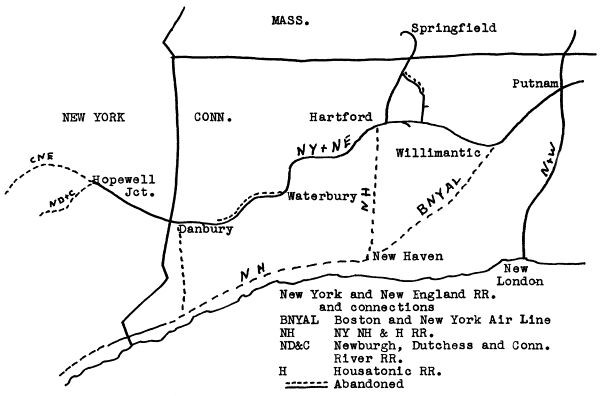
The portion
of the New York and New England RR from Willimantic was opened
from that point to Hartford in 1849 and to Waterbury in 1854.
It reached its connection at Hopewell Jct. with the Newburgh,
Dutchess and Connecticut RR in 1881, using their tracks from Hopewell
Jct. to Fishkill Landing, now Beacon.
A safe formerly belonging to the N D & C RR is now in the
Asst. Supt's. office in Danbury.
For many years, freight was ferried across the river from Newburgh
to Fishkill Landing, and the N Y & N E was a busy freight
road. Today freight is routed via the Poughkeepsie Bridge, over
the old route to Hawleyville and then down to the Shelton loop
to Waterbury and Hartford. The former N Y & N E between Hawleyville
and Waterbury was abandoned in 1948.
The N Y & N E covered a large territory, but it had no
outlet into New York City, and to run trains there, it had to
use the N Y, N H & H tracks from Willimantic or Hartford.
On November 18, 1884, the New York and New England placed the
New England Limited in service between Boston and New York, leaving
both terminals at 3:00 p.m. The running time was six hours and
was routed N Y & N E to Willimantic, then Air Line and New
Haven to New York. This train was succeeded by the famous "Ghost
Train" in 1891 and ran until 1895. This train was also known
as the "White Train", as the cars were painted white.
About 1910 the N Y, N H & H ran two trains a day each way,
from New York to Boston via Waterbury and Bridgeport, using the
N Y & N E route. The trains were numbered 45, 46, 55 and 56.
Anxious to obtain more revenue on their own line, the N Y &
N E tried to arrange to run its trains over its own line to Brewster,
NY and then over the Harlem RR to New York. According to information
received a number of years ago from a reliable old timer, there
was some sort of an agreement between the N Y, N H & H and
the Harlem RR that forestalled the move.
About 1891, the N. Y & N E, in connection with the Long
Island RR. The New England Terminal Co. Ferry and the Housatonic
RR, (Danbury & Norwalk Div.) placed the Long Island &
Eastern States Express in service, Brooklyn to Boston. This train
ran from Brooklyn to Oyster Bay on the LIRR, ferried across Long
Island Sound by the New England Terminal Co. to Wilson Point,
to Hawleyville via the Danbury & Norwalk Div. of the Housatonic
then to Boston via the NY & NE RR.
The Schedule:
|
Read Down |
|
Read Up |
|
Leave |
|
Arrive |
| |
|
|
|
11:00 p.m. |
Boston |
7:00 a.m. |
|
11:43 |
Franklin |
6:13 |
|
12:36 a.m. |
Putnam |
5:23 |
|
1:15 |
Willimantic |
4:45 |
|
1:48 |
Manchester |
4:12 |
|
2:05 |
arr Hartford |
lv 3:55 |
|
2:10 |
lv Hartford |
arr 3:50 |
|
2:30 |
New Britain |
3:35 |
|
2:47 |
Bristol |
3:21 |
|
3:15 |
Waterbury |
2:50 |
|
4:00 |
arr Hawleyville |
lv 2:00 |
|
4:05 |
lv Hawleyville |
|
|
4:55 |
South Norwalk |
1:11 |
|
5:02 |
arr Wilson Point |
lv 1:05 |
|
5:12 |
lv Wilson Point |
arr 12:50 |
|
5:55 |
arr Oyster Bay |
lv 12:05 |
|
6:05 |
lv Oyster Bay |
arr 11:55 p.m. |
|
7:00 a.m. |
arr Brooklyn |
lv 11:00 p.m. |
The above schedule is copied from a public timetable of the
Housatonic RR dated Sept. 21, 1891. The train ran for only a year,
did not show on the 1892 timetable, but trains are shown running
over the same route leaving Boston at 12 noon, due Brooklyn 8:44
p.m.; leaving Brooklyn 9:55 am, due Boston 6:30 p.m.
Another short lived service was the hourly trains the N Y &
N E put on around the late 80's between New Britain and Hartford.
At the same time the N Y, N H & H put on duplicate service
between New Britain and Hartford via Berlin. After running this
duplicate service for a while, both roads called off their dogs.
About 1898, the third rail, known as the power rail, was installed
between Hartford and Bristol and between New Britain and Berlin.
At this time, there was double track between Hartford and Bristol.
One of the tracks was turned over for the use of the third rail
cars and the other track for steam trains, both being operated
under single track rules.
The third rail
cars ran every hour from Hartford to Bristol and every half hour
from Hartford to New Britain. The time card meeting points
were Newington Siding and Cooks. The tracks crossed over at New
Britain. The fare was divided into zones, 10 cents anywhere in
the zone between New Britain and Hartford and 10 cents to stations
in the zone between New Britain and Bristol. The zone tickets
were called dinkey tickets by the public.
As the live, or power, rail was placed between the two running
rails, there were many animals killed by coming into contact with
the live rail. About 1907, President Mellen planned to have the
power rail removed and overhead trolley wire installed. He also
planned to run the cars on the railroad from Bristol to Parkville
and then on the streets through the business district of Hartford.
It seems that the trolleys in Hartford used the grooved instead
of the T rail and wouldn't change. There were many arguments
on the subject, but Hartford wouldn't change and the plan was
abandoned. Steam service was reinstated and ran for a number of
years on the same schedule as the former third rail cars. Later
double track operation was resumed between Hartford and Bristol.
The Rockville RR, (Rockville Branch) was opened, Rockville
to Vernon, August 10, 1863. For many years there was a colored
conductor named Henry Verness, who worked on this road. He first
worked in the freight house in Rockville and later was employed
as a brakeman and worked up to be a passenger conductor. He was
well liked and highly respected by all who knew or worked with
him and when he died, his body lay in state in the townhall in
Rockville.
When the N Y & N E assumed control of the Rockville RR
an agreement was made that Henry could hold his job as conductor
as long as he wanted it, and when the N Y & N E, known at
that time as the New England RR, was leased to the N Y, N H &
H May 10, 1898, the same agreement was in effect. One day Mr.
Mellen saw Henry and ordered him discharged because he was colored.
When Mr. Francis Maxwell, an influential Citizen of Rockville,
heard about Henry, he notified Mr. Mellen that Henry would have
to be put back on his job, or the people of Rockville would take
back their railroad. Henry went back to work. He retired in 1909
after giving many years of faithful service to the railroad.
The Connecticut Central RR, (Springfield Branch) was opened
January 1876 between East Hartford and Springfield. A branch line
was built and opened in 1876 from West St. Rockville, to connect
with the Connecticut Central at Melrose.
The Norwich and Worcester RR was built in 1840 and was leased
to the N Y & N E in 1869, thus giving the railroad a boat
connection from Allyn's Point to New York. This road was later
extended to Groton.
The South Manchester RR was owned and operated for many years
by the Cheney Brothers of silk-mill fame.
May 1, 1892, the Meriden, Waterbury and Connecticut River RR
was leased to the N Y &N E who operated it a few years and
then abandoned it for financial reasons.
The N Y & N E was an expensive railroad to build and like
most of the cross country railroads in this section, it was also
expensive to operate and maintain on account of its many steep
grades.
There were rumors at one time about building a new line from
Hopewell Jct. to a point near Gaylordsville on the Berkshire in
order to eliminate the heavy grade from Hopewell Jct. to Reynoldsville
Summit, but the rumors died down and December 1904 work was started
on double tracking from Stormville to Towners and from there to
Danbury in the spring of 1905. The double track was completed
to Danbury, Wildman St. in 1907. The old Housatonic and N Y &
N E single track lines between 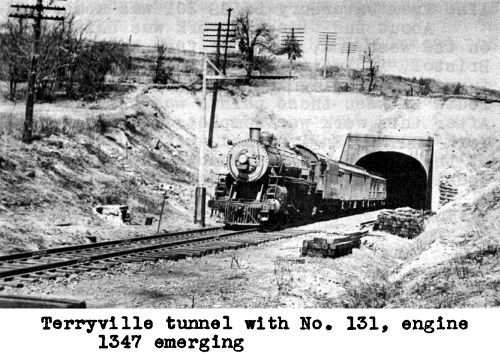 Danbury and what is now known as Berkshire Jct., were
changed to double track operation. From Berkshire Jct. the work
was pushed forward rapidly. At Hawleyville an entirely new route
was built to a point about one mile east of what was later known
as R.X. tower, SS 201. This new route died away with the old Housatonic
and N Y & N E routes between these points. From SS 201, the
old Housatonic route was also double tracked to Derby Jct. thereby
forming a double track line over which thousands of tons of freight
are now handled daily to New Haven and points east and also to
Hartford and Waterbury via the Shelton Loop.
Danbury and what is now known as Berkshire Jct., were
changed to double track operation. From Berkshire Jct. the work
was pushed forward rapidly. At Hawleyville an entirely new route
was built to a point about one mile east of what was later known
as R.X. tower, SS 201. This new route died away with the old Housatonic
and N Y & N E routes between these points. From SS 201, the
old Housatonic route was also double tracked to Derby Jct. thereby
forming a double track line over which thousands of tons of freight
are now handled daily to New Haven and points east and also to
Hartford and Waterbury via the Shelton Loop.
The tunnel on the old Housatonic at Hawleyville was never used
after the new route was built, but the tunnel at Hawleyville on
the old N Y & N E was used by trains to Waterbury via Sandy
Hook until 1948 when the entire line from Waterbury to SS 201
was abandoned.
About the time the work was being done on the west end, the
road from Waterbury to Bristol, including the building of Terryville
tunnel, was being double tracked. Much of the route between those
points was changed. After this work was completed, the old New
York and New England had, with the exception of the road between
Columbia and Vernon, a double track line from Boston to Waterbury.
THE SHEPAUG, LITCHFIELD & NORTHERN R.R.
The Shepaug, Litchfield & Northern RR, was built from Hawleyville
to Litchfield in the early 70's. It was sometimes called the Great
Northern by some of the men who worked on it, because in the fall
of the year, sometimes we had a great time getting over the road
when the leaves were falling.
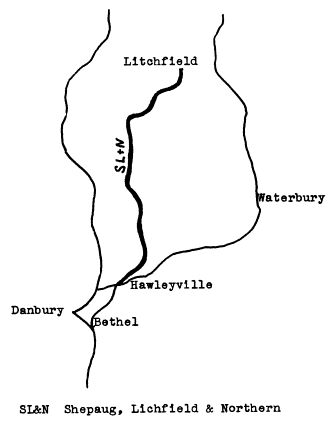 There were
many carloads of stone hauled at one time from the quarries at
Roxbury. It is said that the stone for the Brooklyn Bridge came
from these quarries. In later years, there was a big ice house
built at Bantam Lake. As many as 27 carloads of ice a day were
hauled during the summer, but we shouldn't have said hauled, for
27 carloads didn't need any hauling from Bantam to the Housatonic
River. They just shoved you down, but from there to Hawleyville
you sure had to do some hauling. No more trains of ice from Bantam,
Congamond and other points, the Frigidaire took away this business,
and when cement began to be used for building, the stone quarries
closed down and that business was lost.
There were
many carloads of stone hauled at one time from the quarries at
Roxbury. It is said that the stone for the Brooklyn Bridge came
from these quarries. In later years, there was a big ice house
built at Bantam Lake. As many as 27 carloads of ice a day were
hauled during the summer, but we shouldn't have said hauled, for
27 carloads didn't need any hauling from Bantam to the Housatonic
River. They just shoved you down, but from there to Hawleyville
you sure had to do some hauling. No more trains of ice from Bantam,
Congamond and other points, the Frigidaire took away this business,
and when cement began to be used for building, the stone quarries
closed down and that business was lost.
At one time, it was intended to extend this railroad to Torrington
or Winsted, but it was never built beyond Litchfield.
December 10, 1892, the N Y, N H & H leased the Hawleyville-Bethel
branch to the Shepaug.
50 years ago, there were 2 passenger trains a day each way,
between Bethel and Litchfield. A freight train also made a round
trip from Danbury, via Bethel, to Litchfield. This train did the
local work and handled quite a few cars of milk, and was sometimes
called the little milk.
The Shepaug was leased to the N Y N H & H on July 1, 1898.
In the summer of 1905, a thru train from Litchfield to New
York was put in service. This train did a nice business for a
few summers but by 1913 the automobile got most of the business
and that was the last summer it ran. In 1908 or 9, the two passenger
trains were run into Danbury instead of to Bethel and the branch
from Hawleyville was abandoned June 1911.
The last passenger service on the Litchfield Branch as the
old S L & N was now called, was handled by a good gas-rail
car and in the 30's the passenger service was abandoned., and
as the stone, ice and milk business was gone and trucks taking
away much of what was left, freight trains ran up the branch only
as required, The pieturesque branch was abandoned in the summer
of 1948.
THE MERIDEN, WATERBURY AND CONNECTICUT RIVER RR.
The Meriden and Cromwell RR opened April 6, 1885.
The Meriden and Waterbury RR was opened to Dublin St., Waterbury,
in 1888 The construction from Dublin St. to the New York and New
England connection at Waterbury was completed the same year. This
connecting point, near the present Waterbury engine house, was
known as Meriden Jct. and this connection and a short piece of
the railroad east of Dublin St. is still in use serving the Scoville
Manufacturing Co. and other industries.
These two railroads consolidated in May, 1888 and the new company
was known as the Meriden, Waterbury and Connecticut River RR.
September 1, 1892, this road was leased to the N Y & N E for
99 years. Shortly after a mortgage on the M W & C R was foreclosed
and the New England RR, as the N Y & N E was then called,
ceased to operate it. The purchasers of the foreclosed company
formed a new company which was incorporated in 1898. This company
leased their property to the N Y, N H & H for one year, this
lease being renewed until 1902 when a new lease for 50 years was
made. The railroad was again put in service from Waterbury to
Westfield, Conn. using the Berlin Branch from that point to Middletown.
The track from Westfield to Cromwell was not restored and the
rails and ties were removed in 1904. Trains now made two round
trips week days between Middletown and Waterbury. Trolley service
was installed between East Meriden and Middletown in 1907 and
the steam train's now made two round trips week days between Meriden
and Waterbury. Later this service was cut to one round trip.
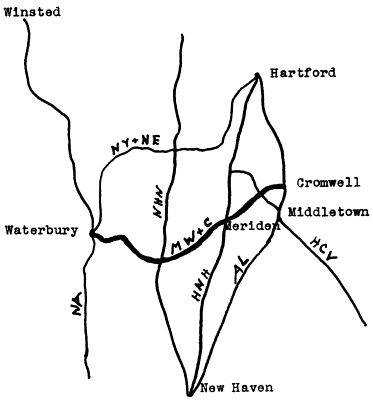 The last train
service Meriden to Waterbury was June 24,1917, as shortly after
the start of World War I, passengers had dropped to one a day,
a man named Mr. Kendricks, who worked at Scoville and had been
commuting from Wallingford to Waterbury via Meriden and the M
W & C R for many years. He put up an awful kick when he heard
the road was to be abandoned, even taking his case to Washington,
D. C., but in 1924, the road was abandoned 1000 feet west of West
Main St. Station, Meriden to East Farms station. The trolley cars,
which ran in the street from the station on the Hartford road
in Meriden to East Meriden, (Highland) and thence to Middletown
on the old M W & C R, ran for a few years more. These cars
were operated as trains, running by timetable from East Meriden
(Highland to Westfield and from there to Middletown by the staff
system.
The last train
service Meriden to Waterbury was June 24,1917, as shortly after
the start of World War I, passengers had dropped to one a day,
a man named Mr. Kendricks, who worked at Scoville and had been
commuting from Wallingford to Waterbury via Meriden and the M
W & C R for many years. He put up an awful kick when he heard
the road was to be abandoned, even taking his case to Washington,
D. C., but in 1924, the road was abandoned 1000 feet west of West
Main St. Station, Meriden to East Farms station. The trolley cars,
which ran in the street from the station on the Hartford road
in Meriden to East Meriden, (Highland) and thence to Middletown
on the old M W & C R, ran for a few years more. These cars
were operated as trains, running by timetable from East Meriden
(Highland to Westfield and from there to Middletown by the staff
system.
M W & C Meriden, Waterbury
and Conn. River
NA Naugatuck
NHN New Haven & Northampton
HNH Hartford & New Haven AL Air Line
THE NEW HAVEN, MIDDLETOWN AND WILLIMANTIC R.R.
 The New Haven,
Middletown and Willimantic RR was opened to Willimantic, the last
rail being laid Friday, April 25, 1873. This is a simple statement,
but it was a hard road to build, and at Hartford, the steamboat
interests were strongly opposed to the building of a drawbridge.
At that time, Connecticut had two capitols, New Haven and Hartford,
and in the years the General Assembly met in Hartford, the railroad
was unable to receive any favors. A suspension bridge was planned
over the Narrows south of Middletown, but the idea was given up
as it was thought that a bridge of this type could not be made
strong enough to hold a train. There was much discussion back
and forth, but in 1868 the General Assembly met in New Haven and
a charter was issued to build the drawbridge at its present location.
The New Haven,
Middletown and Willimantic RR was opened to Willimantic, the last
rail being laid Friday, April 25, 1873. This is a simple statement,
but it was a hard road to build, and at Hartford, the steamboat
interests were strongly opposed to the building of a drawbridge.
At that time, Connecticut had two capitols, New Haven and Hartford,
and in the years the General Assembly met in Hartford, the railroad
was unable to receive any favors. A suspension bridge was planned
over the Narrows south of Middletown, but the idea was given up
as it was thought that a bridge of this type could not be made
strong enough to hold a train. There was much discussion back
and forth, but in 1868 the General Assembly met in New Haven and
a charter was issued to build the drawbridge at its present location.
Another big job was the building of the Rapello and the Lyman
Viaducts, east of Easthampton. The Lyman Viaduct was 1100 feet
long and 137 feet high. These viaducts were built wide enough
(as were many of the bridge abutments) to allow for double tracks.
These viaducts were filled in during 1912 and 1913.
While on the subject, we might mention the bridge at Muddy
River, about two miles south of old Nortford station there is
a highway bridge over Muddy River and a railroad bridge at right
angles over the highway bridge. A bridge over a bridge.
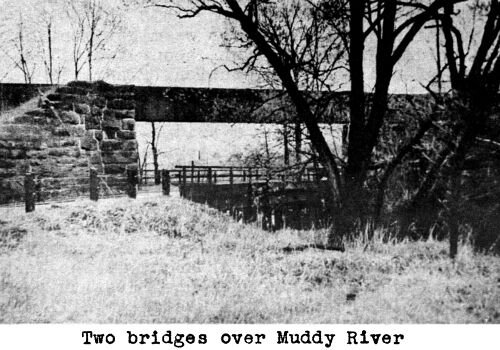 The New Haven,
Middletown and Willimantic RR., later the Boston and New York
Air Line, is known to most of us as the Air Line, because it is
the shortest distance between Boston and New York.
The New Haven,
Middletown and Willimantic RR., later the Boston and New York
Air Line, is known to most of us as the Air Line, because it is
the shortest distance between Boston and New York.
Many famous trains have run over this road. The Federal Express,
first known as the Washington Night Express, made its first trip
on, May 8. 1876, running from Boston to Willimantic over the N
Y & N E and from there to Harlem River via the Air Line and
the New Haven. A little later it ran via Hartford until January
29, 1893 when it was routed over the Shore Line, except when the
steamer Maryland, which ferried the train from Harlem River to
Jersey City, burned. The train was routed over the N Y & N
E to the connecting railroad west of the Hudson River and ran
over this route from December 28, 1888 to May 11, 1890 when service
was resumed via Hartford and Harlem River. With the exception
of 1912 to 1917, while the Hell Gate Bridge was under construction,
this train has been running over the Shore Line ever since.
During 1912 to 1917, the train ran via Devon, Danbury and the
Poughkeepsie Bridge route to Maybrook.
The Federal was one of the first named trains in the United
States.
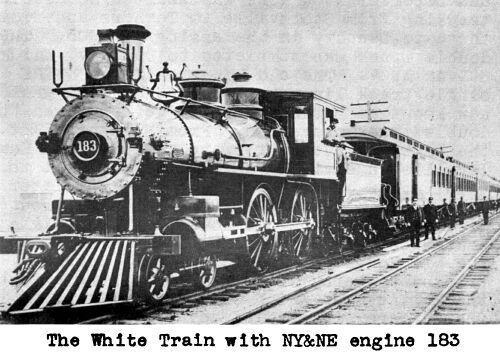 The N Y &
N E's New England Limited used this route and on March 16, 1891,
this train was succeeded by the White Train, or Ghost Train.
The N Y &
N E's New England Limited used this route and on March 16, 1891,
this train was succeeded by the White Train, or Ghost Train.
No doubt there has been more written about the Ghost Train
and the Fall River Line Express than any other trains in the country.
Engineer Gene Potter ran the train, and in a letter stated that
the train crew wore white caps and gloves. This train was a beautiful
sight, especially when the setting sun shone on it and also on
a moonlit night. The train was very popular, but it was hard to
keep clean and it made its last run on November 20, 1895.
There has been almost as much written about Gene Potter as
has been about Casey Jones. Gene made his last trip on trains
45 and 56, round trip Boston to Waterbury, on December 18, 1922.
The Ghost Train was succeeded by the Air Line Limited, the
first five hour train to run between New York and Boston. Later,
N Y & N E engine #2 was built for this train. Engineer Potter,
who ran the train, said she was a corker, built by Schenectady,
the engine became New Haven 902, later 1410. Middletown was the
only stop the train made between Boston and New York 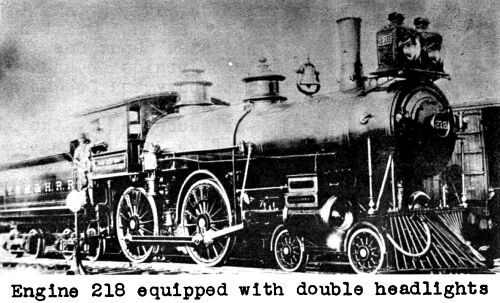 and was said to have been the longest
nonstop run in the country at that time. The engines scooped water
at track-pans at Rowayton and Putnam and were equipped with two
headlights. Hartford newspapers gave New Haven an awful razzing
because the train didn't stop there. Mr. Potter said that because
of its growing popularity it became too heavy for the grades on
the Air Line and made its last trip over this route on May 17,
1902. It was routed over the Shore Line and was known as the Knickerbocker.
and was said to have been the longest
nonstop run in the country at that time. The engines scooped water
at track-pans at Rowayton and Putnam and were equipped with two
headlights. Hartford newspapers gave New Haven an awful razzing
because the train didn't stop there. Mr. Potter said that because
of its growing popularity it became too heavy for the grades on
the Air Line and made its last trip over this route on May 17,
1902. It was routed over the Shore Line and was known as the Knickerbocker.
This was the last New York-Boston service over the Air Line.
Later for a while, there was a train, to New York from Fitchburg,
which came via Worcester, Putnam, and Willimantic, over the Air
Line to New Haven.
For a while the famous Cannonball fish train ran over the Air
Line. This train was made up solid with cars of fish every night,
from Boston to New York.
During the season, peach trains ran via the Air Line. A letter
from Mr. Peckham contained copies of the following messages:
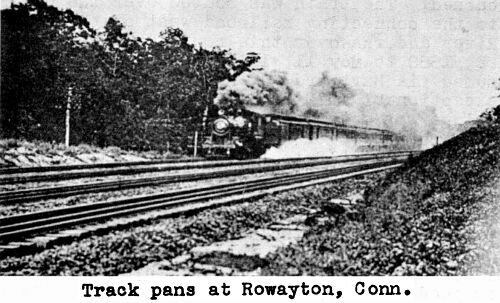 "August
9, 1883. NOTICE: Peach trains over the Air Line Division
will commence running tomorrow, Friday and may be expected every
day. Keep a good lookout for signals on regular trains and for
extras Sundays without signals.
"August
9, 1883. NOTICE: Peach trains over the Air Line Division
will commence running tomorrow, Friday and may be expected every
day. Keep a good lookout for signals on regular trains and for
extras Sundays without signals.
O. M., Shepard, Supt."
"October 6, 1883. NOTICE: Several extra trains
in both directions on Air Line Division may be expected after
9:00 a.m. tomorrow, Sunday Oct. 7th.
O. M. Shepard, Supt."
This gives an example of the business on the Air Line in the
good old days. Mr. Peckham says that he, sometimes while agent
and operator at Middlefield worked from 7:20 a.m. to 1:30 a.m.
next day. Twenty-six trains passed thru Middlefield during those
hours. At 1:30, the dispatcher would say "Good night, hurry
back." No overtime pay in those days.
During World War I, the State of Maine Express was routed over
the Air Line to relieve the congestion on the Shore Line. Many
trains were routed over the Air Line when the Little River bridge
burned and also during the flood in 1938 and other occasions.
The Air Line was put to good use on another occasion. During
the hurricane of 1938, the water in the Connecticut River was
almost up to the drawbridge. All highway traffic in Portland was
stalled because of the high water and at this time a lady in Portland
had a very important appointment at Middletown Hospital. There
happened to be an engine and caboose at Portland, so they placed
the lady in the caboose and carefully went over the drawbridge
to Middletown, the lady arriving at the hospital just in time.
Middletown, at the beginning of the century, was a big railroad
center. There were 6 or 8 runs tied up there, and there were about
40 passenger trains in and out of there every day.
Many carloads of stone used in building the brownstone fronts
we've heard about were hauled from the Portland quarries, as were
many cars loaded with trap rock from Reeds Gap, which was used
to build the highways over which you now ride in your automobile.
At one time there was a double track section on the Air Line from
a point 0.71 miles west of Portland to Cobalt.
A fine historical novel written by Margaret Allis, entitled
The Bridge, gives interesting historical background to the building
of the Air Line and the arguments, pro and con, in regards to
the building of the drawbridge. The book should be read by all
who are interested in the history of the famous Air Line Railroad.
The Colchester Railway, (Colchester branch) was opened, Colchester
to Turnerville, now Amston, August 3, 1877, and was leased to
the Boston and New York Air Line Railroad.
The Boston and New York Air Line Railroad was deeded to the
N Y, N H & H on January 30, 1907.
THE NEW HAVEN & NEW LONDON RAILROAD
THE HARTFORD AND CONNECTICUT VALLEY RAILROAD
The New Haven & New London RR, later known as the Shore
Line Railway, was opened in 1852. It was leased to the New York
and New Haven in 1870 and the latter railroad built the drawbridge
over the Connecticut River soon after. This railroad was a single
track line and trains were operated right by direction.
In 1892 and 93, the double tracking of the Shore Line was in
process. An entirely new line was built from Cedar Hill to East
Haven, including the tunnel between Fair Haven and East Haven.
This new piece of track eliminated the many highway crossings
at grade between Cedar Hill and Fair Haven.
The National Folding Box Co's. side track at Cedar Hill is
part of the old Shore Line RR. and the portion of the old main
line that connects with the present main line at East Haven is
at industrial side track from that point to Fair Haven East. The
old Cedar Hill Station stood between the Shore Line tracks And
the Hartford tracks. Many remains of the old trestles can be seen,
still standing in many places.
After obtaining the New York, Providence & Boston and the
old Colony railroads, (control of the latter giving them the important
last link in the Boston and Providence RR), the N Y, N H &
H could now collect revenue over its own lines from New York to
Boston.
The Hartford & Connecticut Valley Railroad, formerly called
the Connecticut Valley, was completed Hartford to Saybrook in
1871 and to Saybrook Point in 1872.
For many years there was good passenger business on this line,
being very heavy during the summer months, as it was a quick way
for Hartford and Middletown people to get back and forth to the
shore resorts. Automobiles took their toll, however, and in the
late twenties passenger service was abandoned. It was too bad
to see it go, as it was a beautiful ride along this road by the
river.
The H & C V was leased to the N Y, N H & H in 1887.
THE CENTRAL NEW ENGLAND RAILWAY
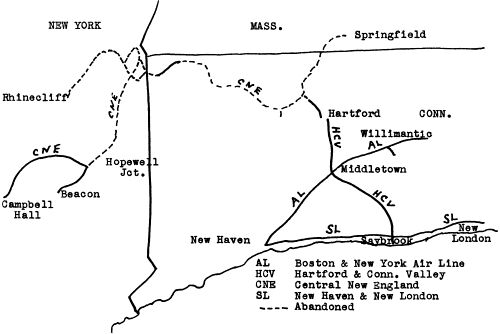 Another famous
railroad, known in later years as the Central New England Railway,
was the last railroad in the lines west territory to be acquired
by the N Y, N H & H. It was merged into the larger road on
May 10, 1927. Its grades were the steepest of any of the cross
country railroads with the possible exception of the grade between
West Cheshire and Summit on the Meriden, Waterbury and Connecticut
River RR. Norfolk Summit was over 1300 feet above sea level and
Norfolk station was the highest, about 1200 feet above sea level,
in the entire system. In spite of these stiff grades, this road
did a large freight business for many years and also ran many
passenger trains.
Another famous
railroad, known in later years as the Central New England Railway,
was the last railroad in the lines west territory to be acquired
by the N Y, N H & H. It was merged into the larger road on
May 10, 1927. Its grades were the steepest of any of the cross
country railroads with the possible exception of the grade between
West Cheshire and Summit on the Meriden, Waterbury and Connecticut
River RR. Norfolk Summit was over 1300 feet above sea level and
Norfolk station was the highest, about 1200 feet above sea level,
in the entire system. In spite of these stiff grades, this road
did a large freight business for many years and also ran many
passenger trains.
A timetable of the Central New England and Western RR Co.,
of June 30,1890, shows 8 trains on week days out of Hartford.
It also shows a Day Express Train with Pullman buffet parlor cars
Boston to Harrisburg, Pa., without change, via the Poughkeepsie
Bridge Route. This train left Boston at 8:00 a.m., arriving in
Harrisburg at 12:10 that night. It also shows a train leaving
Boston at 5:45 p.m. for Philadelphia, Baltimore and Washington,
with Pullman buffet and sleeping cars, arriving at Washington
at 11:20 a.m. next day. These trains ran from Boston to Northampton
via the Boston and Maine (former Central Massachusetts RR) and
from there to Simsbury via the N Y, N H & H, then to Campbell
Hall and the connecting road, via the C N E & W.
Later in the 90's this railroad was known as the Philadelphia,
Reading and New England RR. In the summer of 1898 they put out
a very interesting book, consisting of over 175 pages, showing
many beautiful pictures of the wonderful scenery for which this
road is noted.
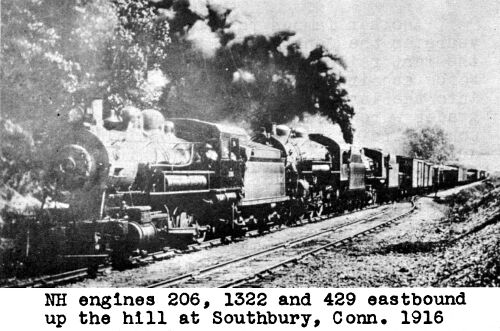 There was
also through passenger service between Winsted and New York via
Millerton and the Harlem Railroad. The C N E must have had better
luck than the N Y & N E when it came to arranging thru service
over the Harlem from Brewster to New York.
There was
also through passenger service between Winsted and New York via
Millerton and the Harlem Railroad. The C N E must have had better
luck than the N Y & N E when it came to arranging thru service
over the Harlem from Brewster to New York.
The building of the Poughkeepsie Bridge was one of the most
wonderful engineering feats of that period. It gave, up to the
time the Hell Gate Bridge was completed, the only all rail line
to western connections. At the present time, thousands of tons
of freight are hauled daily over this bridge. It was double-tracked
about 1917 or 18, and later, when the bridge was strengthened
on account of heavier engines being used, the tracks were gauntleted.
The first train over Poughkeepsie Bridge was on December 29,
1888. It was hauled by engine No. 10. We wonder what people of
that date would say if they could see the big trains that cross
that bridge today.
At Millerton and Boston Corners, when trains of the N D &
C and C N E railroads wanted to cross the Harlem RR. a large gate
was swung across their track. All Harlem RR trains had to make
a "know nothing" stop at these points. This arrangement
was in effect for a number of years after regular service on the
old N D & C and C N E railroad had been discontinued. One
summer a robin built a nest and hatched her young on the gate
at Boston Corners and was not alarmed when the gate was used.
The portions of these old railroads still in operation are
as follows:
Maybrook to Hopewell, Beacon and Hopewell, Hartford and Griffins,
Canaan and Lakeville. All of the remainder of these famous railroads
have been abandoned, but, the memory of the 100% railroad men
who worked on them will never be forgotten.
MISCELLANY
There were two other portions of Lines West abandoned, which
should have been mentioned before. The Berlin branch between Berlin
and East Berlin and the line between Stepney and North Bridgeport
on the old Housatonic RR.
When the Middletown-Berlin branch was first electrified, the
operation was turned over to the Connecticut Company, but later
a larger type of car was placed in service and the operation was
turned back to the railroad.
Besides the trolleys that ran on the railroad from Westfield
to East Meriden, as had been stated, they also ran between Middletown
and Cromwell on the Valley Main Line and were operated by the
Staff System. Portland cars came over the old highway bridge,
received a proceed indication on a dwarf signal, and ran on the
Valley, crossing the Air Line and then running on the street and
onto Main Street, Middletown. They had the best trolley system
of any city in the state.
Trolley cars also ran on the main line from Burnside Jct. to
Vernon and Rockville; and on the Norwich branch from Tafts to
Central Village. Between these points, the cars were operated
as regular trains and the timetable stated: Electric Passenger
trains 30 minutes or more late would lose both right and schedule.
The last portion of the railroad to be electrified was the
line between South Norwalk and Danbury. The first electric train
into Danbury was a "Mutt" No. 4089, June 29, 1925; the
first motor was the 074. Regular electric service between South
Norwalk and Danbury commenced July 6, 1925, doing away with the
steam engines between those points with the exception of the dock
local and the wire train.
In 1913 there was a railroad constructed from Springfield,
Mass. to Bondsville, Mass., on the Boston and Maine. The reason
for building this road was to run trains into North Station, Boston,
so that passengers for points beyond Boston on the B & M would
not have to transfer from South to North Stations in Boston. For
some reason, trains were never run over this road. It was known
as the Hampden, or Bondsville, road.
Many people seem to confuse this road with the Palmer-Providence
road which was under construction about this time by the Grand
Trunk RR. This was a separate project and had nothing to do with
the Hampden Road. Many of the fills and bridge abutments of the
Southern New England RR, which was never completed, can be seen
in the vicinity of northwestern Rhode Island and along the old
N Y & N E route between Blackstone and East Douglas.
The New York, New Haven and Hartford, monogram, which, no doubt,
is the finest in the country, was designed by Mr. C. T. Hempstead,
who was General Passenger Agent at the time. He sketched it one
morning while riding to work. He had it printed and it has been
used ever since and we hope it always will be.
Well, there have been many changes on the railroad in the last
50 or 60 years, which is about as far back as our memory of the
railroad goes. Remember the most popular car on the railroad,
the PAY CAR? On pay day you would meet many of the brothers and
get the gossip from all over the road, the many fast runs that
were made and the heavy, trains hauled. In October 1927, the company
started paying by check and the old pay car was no more.
How many can remember when a white light was used for a proceed
(clear) signal? This was changed to green about 1899 as a safety
measure.
In the early 1900's, all stations on the single track lines
all over the system that had East, North, South or West as part
of their names, were changed, for example, South Kent was changed
to Lilly Lade, later Woodrow; North Kent was changed to Flanders,
etc.
Remember when trains for the Naugatuck were required to blow
one long, two shorts and a long whistle at the River Road tower
just west of the drawbridge at Naugatuck Jct.; and the old covered
bridge at Derby Jct. on the Shelton Route. Also the indicators
in the cabooses showing the number or symbol of the train, or
engine number if an extra? And when green flags were used by day
for markers, and green lights showing green to the front and.
side in marker lamps at night, also the time boards (Dutch Clocks)?
Many more things are gone and mostly forgotten.
Quite a few of the freight trains had unofficial names. Dark
Secret, the Dogo, Dutch Owl, Dingbat, Brick Extra, Hog train,
Rawhide, Hotfoot, Midnight Horror, and ones with a more cheerful
name the Moonlight, Merry Go Round, Hot Shot. On the Hartford,
Canal, Naugy and Berkshire there the Peirs and many more.
We have been very fortunate for many years in having as fine
operating officials to work under as can be found anywhere in
the country. They have all worked their way up from the ranks
and they know the game right from the bottom. It has been a pleasure
to have worked, with men in all classes of service for 50 years
and in looking back on all these years, we realize it would be
impossible to find a finer bunch of men, if you looked the world
over. We must also compliment the telephone girls connected with
the railroad for the fine and unusual courtesies they have shown
in taking care of calls.
As we can begin to see the lights of the Great Terminal, it
gives us a great deal of pleasure to have known and worked with
these Real People.
New
England RR | Antebellum RR | Contents Page
This page originally appeared on Thomas Ehrenreich's Railroad Extra Website







